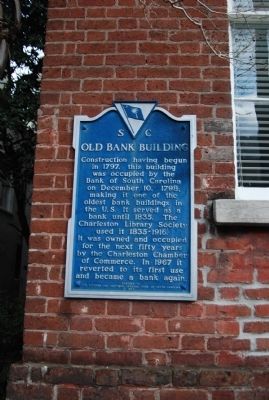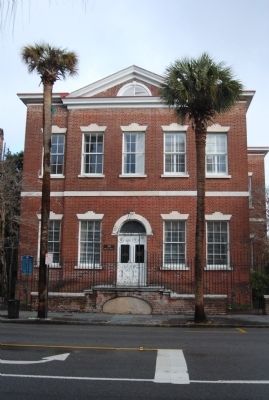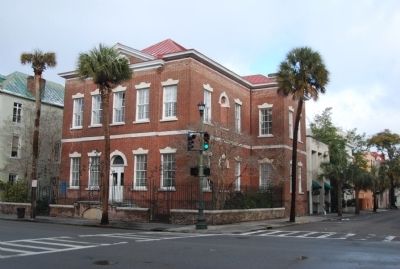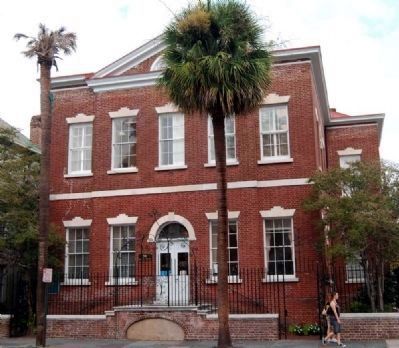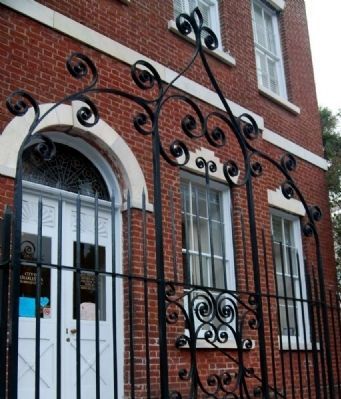French Quarter in Charleston in Charleston County, South Carolina — The American South (South Atlantic)
Old Bank Building
Construction having begun in 1797, this building was occupied by the Bank of South Carolina on December 10, 1798, making it one of the oldest bank buildings in the U.S. It served as a bank until 1835. The Charleston Library Society used it 1835-1916. It was owned and occupied for the next fifty years by the Charleston Chamber of Commerce. In 1967 it reverted to its first use and became a bank again.
Erected 1967 by Citizens and Southern National Bank of South Carolina. (Marker Number 10-4.)
Topics. This historical marker is listed in these topic lists: Industry & Commerce • Notable Buildings. A significant historical month for this entry is December 1935.
Location. 32° 46.602′ N, 79° 55.77′ W. Marker is in Charleston, South Carolina, in Charleston County. It is in the French Quarter. Marker is at the intersection of Broad Street and Church Street, on the left when traveling east on Broad Street. Marker is attached to the Broad Street (south) facade, to the left of the entrance. Touch for map. Marker is at or near this postal address: 50 Broad Street, Charleston SC 29401, United States of America. Touch for directions.
Other nearby markers. At least 10 other markers are within walking distance of this marker. Clark Mills Studio (a few steps from this marker); Ancient and Accepted Scottish Rite of Freemasonry / Solomon's Lodge No. 1 (within shouting distance of this marker); Shepheard's Tavern (within shouting distance of this marker); The Society of the Cincinnati of the State of South Carolina (within shouting distance of this marker); The Grand Lodge of Ancient Freemasons of South Carolina (within shouting distance of this marker); The Confederate Home (within shouting distance of this marker); William A. Giles (within shouting distance of this marker); Daniel Ravenel II House (within shouting distance of this marker); Bible Depository (within shouting distance of this marker); Broad Street Site of Domestic Slave Trade (about 300 feet away, measured in a direct line). Touch for a list and map of all markers in Charleston.
Regarding Old Bank Building. National Register of Historic Places:
Citizens and Southern National Bank of South Carolina *** (added 1971 - - #71000747)
♦ Historic Significance: Event, Architecture/Engineering
♦ Area of Significance: Education, Architecture, Commerce
♦ Period of Significance: 1825-1849, 1750-1799
♦ Historic Function: Commerce/Trade
Also see . . .
1. Citizens and Southern National Bank of South Carolina. Significant in the commercial history of Charleston and the nation, the building was built as a bank and was used as such from 1798 to 1835, a role assumed again in 1966 when Citizens and Southern National Bank acquired the property. (Submitted on September 27, 2011, by Brian Scott of Anderson, South Carolina.)
2. Charleston Library Society. Official website of the Charleston Library Society. (Submitted on September 27, 2011, by Brian Scott of Anderson, South Carolina.)
3. Charleston Library Society. Charleston Library Society, founded in 1748, is a subscription library in Charleston, South Carolina. (Submitted on September 27, 2011, by Brian Scott of Anderson, South Carolina.)
Additional commentary.
1. Citizens & Southern National Bank of South Carolina - National Register Nomination Form
Description
Built as a bank in 1798, the two-story, red brick building has limestone trim over windows and doors, hipped roof and T-shaped floor plan. building's over-all depth is 55 feet, 6 inches and the width at the widest point is 60 feet.
The first floor facade of extended center wing features a pair of steeped arch windows on either side of double, three-panel door with fanlight. The walls on the first floor are 36 inches wide, and window sills measure 28 inches. Second floor level of facade has three six-over-six stepped arch windows and is surmounted by triangular pediment with semi-circular fanlight.
Exterior has been restored to original appearance except for two minor alterations. An outside stairway is believed to have led to the second floor, west side. After the 1886 earthquake, the original fanlight was replaced by the present stained glass Victorian fanlight. A Victorian tower was also added in 1886 but later disappeared. The iron grill work fence was copied from c. 1868 photographs of the original fence which was also destroyed by the earthquake.
The reception room has original, carved woodwork, original black and white marble tile floor and graceful, cluster columns. Interior arch of main doorway has bas-relief carving of eagles. The rest of the building's interior has been changed to be suitable for modern business. Trust Department is on first floor with offices of bond department and system personnel on second.
Basement area with vaulted ceiling and original tiles once housed the vault of the Bank of South Carolina. Basement now known as the Hunley Museum houses a full size reproduction of he Confederate submarine Hunley, first submarine to sink a ship in combat.
Driveways on
east and west sides of building were converted late small gardens, typical of the charming courtyard gardens for which Charleston is noted. In constructing the west garden, an old well complete with original clay pipes was uncovered. E. Milby Burton, Director of the Charleston Museum, identifies the well as colonial; thought to have been part of an early fire fighting system.
Significance
Significant architectural example of the beauty and strength with which 18th century businessmen planned and built. (For this reason, the reception room is open from 9 A.M. to 5 P.M., Monday through Friday, so that the bank can share the building's 18th century heritage with the public.)
Significant in the commercial history of Charleston and the nation, the building was built as a bank and was used as a bank and was used as such from 1798 until 1835, a role assumed again in 1966, when Citizens and Southern National Bank acquired the property. It is believed to be the oldest building built for a bank now in use as a bank in the United States. (The First Bank of the United States in Philadelphia, built 1797, still stands but has not been used as a bank in 30 years.)
The use of the building from 1835 to 1966 contributes variety to its significance. The fact that it housed the Charleston Library Service, one of the oldest in the United States, from 1835 until 1916, gives it distinction in the areas of education and literature.
Adding significance to the building's commercial role, the Charleston Chamber of Commerce, also one of the oldest in the country, had its headquarters here from 1916 until 1966.
The small east garden, an excellent example of landscape architecture, was awarded the Judges Award of the American Association of Nurserymen as being the best business or industrial landscaping in 1969. The award was presented to Hugh C. Lane, chairman of the bank's board, by Mrs. Richard M. Nixon.
— Submitted December 10, 2011, by Brian Scott of Anderson, South Carolina.
Credits. This page was last revised on February 16, 2023. It was originally submitted on February 14, 2010, by Michael Sean Nix of Spartanburg, South Carolina. This page has been viewed 1,095 times since then and 34 times this year. Photos: 1, 2, 3. submitted on February 14, 2010, by Michael Sean Nix of Spartanburg, South Carolina. 4. submitted on October 10, 2011, by Brian Scott of Anderson, South Carolina. 5. submitted on September 27, 2011, by Brian Scott of Anderson, South Carolina. • Bill Pfingsten was the editor who published this page.
